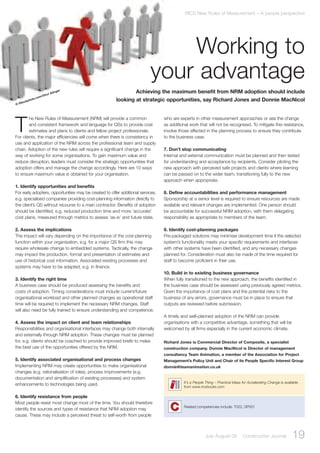
RICS New Rules of Measurement - RICS Article
- 1. July-August 09 Construction Journal 19 he New Rules of Measurement (NRM) will provide a common and consistent framework and language for QSs to provide cost estimates and plans to clients and fellow project professionals. For clients, the major efficiencies will come when there is consistency in use and application of the NRM across the professional team and supply chain. Adoption of the new rules will require a significant change in the way of working for some organisations. To gain maximum value and reduce disruption, leaders must consider the strategic opportunities that adoption offers and manage the change accordingly. Here are 10 ways to ensure maximum value is obtained for your organisation. 1. Identify opportunities and benefits For early adopters, opportunities may be created to offer additional services, e.g. specialised companies providing cost-planning information directly to the client’s QS without recourse to a main contractor. Benefits of adoption should be identified, e.g. reduced production time and more ‘accurate’ cost plans, measured through metrics to assess ‘as-is’ and future state. 2. Assess the implications The impact will vary depending on the importance of the cost-planning function within your organisation, e.g. for a major QS firm this may require wholesale change to embedded systems. Tactically, the change may impact the production, format and presentation of estimates and use of historical cost information. Associated existing processes and systems may have to be adapted, e.g. in finance. 3. Identify the right time A business case should be produced assessing the benefits and costs of adoption. Timing considerations must include current/future organisational workload and other planned changes as operational staff time will be required to implement the necessary NRM changes. Staff will also need be fully trained to ensure understanding and competence. 4. Assess the impact on client and team relationships Responsibilities and organisational interfaces may change both internally and externally through NRM adoption. These changes must be planned for, e.g. clients should be coached to provide improved briefs to make the best use of the opportunities offered by the NRM. 5. Identify associated organisational and process changes Implementing NRM may create opportunities to make organisational changes (e.g. rationalisation of roles), process improvements (e.g. documentation and simplification of existing processes) and system enhancements to technologies being used. 6. Identify resistance from people Most people resist most change most of the time. You should therefore identify the sources and types of resistance that NRM adoption may cause. These may include a perceived threat to self-worth from people T who are experts in other measurement approaches or see the change as additional work that will not be recognised. To mitigate this resistance, involve those affected in the planning process to ensure they contribute to the business case. 7. Don’t stop communicating Internal and external communication must be planned and then tested for understanding and acceptance by recipients. Consider piloting the new approach with perceived safe projects and clients where learning can be passed on to the wider team, transitioning fully to the new approach when appropriate. 8. Define accountabilities and performance management Sponsorship at a senior level is required to ensure resources are made available and relevant changes are implemented. One person should be accountable for successful NRM adoption, with them delegating responsibility as appropriate to members of the team. 9. Identify cost-planning packages Pre-packaged solutions may minimise development time if the selected system’s functionality meets your specific requirements and interfaces with other systems have been identified, and any necessary changes planned for. Consideration must also be made of the time required for staff to become proficient in their use. 10. Build in to existing business governance When fully transitioned to the new approach, the benefits identified in the business case should be assessed using previously agreed metrics. Given the importance of cost plans and the potential risks to the business of any errors, governance must be in place to ensure that outputs are reviewed before submission. A timely and well-planned adoption of the NRM can provide organisations with a competitive advantage, something that will be welcomed by all firms especially in the current economic climate. Richard Jones is Commercial Director of Composite, a specialist construction company. Donnie MacNicol is Director of management consultancy Team Animation, a member of the Association for Project Management’s Policy Unit and Chair of its People Specific Interest Group donnie@teamanimation.co.uk It’s a People Thing – Practical Ideas for Accelerating Change is available from www.ricsbooks.com Related competencies include: T022, SP001 Working to your advantage Achieving the maximum benefit from NRM adoption should include looking at strategic opportunities, say Richard Jones and Donnie MacNicol RICS New Rules of Measurement – A people perspective © iStockphoto.com/Onur Döngel
